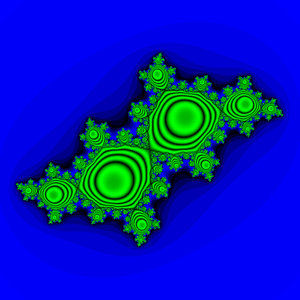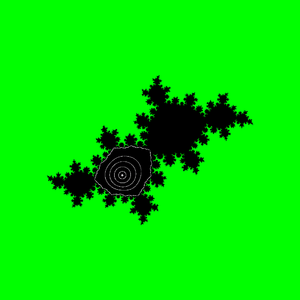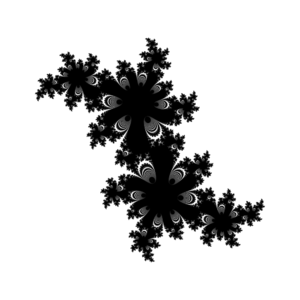Siegel disc
Siegel disc is a connected component in the Fatou set where the dynamics is analytically conjugated to an irrational rotation.
Description
Given a holomorphic endomorphism  on a Riemann surface
on a Riemann surface  we consider the dynamical system generated by the iterates of
we consider the dynamical system generated by the iterates of  denoted by
denoted by  . We then call the orbit
. We then call the orbit  of
of  as the set of forward iterates of
as the set of forward iterates of  . We are interested in the asymptotic behavior of the orbits in
. We are interested in the asymptotic behavior of the orbits in  (which will usually be
(which will usually be  , the complex plane or
, the complex plane or  , the Riemann sphere), and we call
, the Riemann sphere), and we call  the phase plane or dynamical plane.
the phase plane or dynamical plane.
One possible asymptotic behavior for a point  is to be a fixed point, or in general a periodic point. In this last case
is to be a fixed point, or in general a periodic point. In this last case  where
where  is the period and
is the period and  means
means  is a fixed point. We can then define the multiplier of the orbit as
is a fixed point. We can then define the multiplier of the orbit as  and this enables us to classify periodic orbits as attracting if
and this enables us to classify periodic orbits as attracting if  superattracting if
superattracting if  ), repelling if
), repelling if  and indifferent if
and indifferent if  . Indifferent periodic orbits split in rationally indifferent and irrationally indifferent, depending on whether
. Indifferent periodic orbits split in rationally indifferent and irrationally indifferent, depending on whether  for some
for some  or
or  for all
for all  , respectively.
, respectively.
Siegel discs are one of the possible cases of connected components in the Fatou set (the complementary set of the Julia set), according to Classification of Fatou components, and can occur around irrationally indifferent periodic points. The Fatou set is, roughly, the set of points where the iterates behave similarly to their neighbours (they form a normal family). Siegel discs correspond to points where the dynamics of  is analytically
conjugated to an irrational rotation of the complex disc.
is analytically
conjugated to an irrational rotation of the complex disc.
Name
The disk is named in honor of Carl Ludwig Siegel.
Gallery
-

Siegel disc for a polynomial-like mapping
-

Julia set for
 , where
, where  and
and  is the golden ratio. Orbits of some points inside the Siegel disc emphasized
is the golden ratio. Orbits of some points inside the Siegel disc emphasized -

Julia set for
 , where
, where  and
and  is the golden ratio. Orbits of some points inside the Siegel disc emphasized. The Siegel disc is either unbounded or its boundary is an indecomposable continuum.[1]
is the golden ratio. Orbits of some points inside the Siegel disc emphasized. The Siegel disc is either unbounded or its boundary is an indecomposable continuum.[1] -

Filled Julia set for
 for Golden Mean rotation number with interior colored proportional to the average discrete velocity on the orbit = abs( z_(n+1) - z_n ). Note that there is only one Siegel disc and many preimages of the orbits within the Siegel disk
for Golden Mean rotation number with interior colored proportional to the average discrete velocity on the orbit = abs( z_(n+1) - z_n ). Note that there is only one Siegel disc and many preimages of the orbits within the Siegel disk -

Filled Julia set for
 for Golden Mean rotation number with Siegel disc and some orbits inside
for Golden Mean rotation number with Siegel disc and some orbits inside -

Julia set of quadratic polynomial with Siegel disk for rotation number [3,2,1000,1...]
- ^ Rubén Berenguel and Núria Fagella An entire transcendental family with a persistent Siegel disc, 2009 preprint: arXiV:0907.0116
Formal definition
Let  be a holomorphic endomorphism where
be a holomorphic endomorphism where  is a Riemann surface, and let U be a connected component of the Fatou set
is a Riemann surface, and let U be a connected component of the Fatou set  . We say U is a Siegel disc of f around the point z_0 if there exists an analytic homeomorphism
. We say U is a Siegel disc of f around the point z_0 if there exists an analytic homeomorphism  where
where  is the unit disc and such that
is the unit disc and such that  for some
for some  and
and  .
.
Siegel's theorem proves the existence of Siegel discs for irrational numbers satisfying a strong irrationality condition (a Diophantine condition), thus solving an open problem since Fatou conjectured his theorem on the Classification of Fatou components.[1]
Later A. D. Brjuno improved this condition on the irrationality, enlarging it to the Brjuno numbers.[2]
This is part of the result from the Classification of Fatou components.
See also
| Wikibooks has a book on the topic of: Fractals/Iterations in the complex plane/siegel |
References
- ↑ Lennart Carleson and Theodore W. Gamelin, Complex Dynamics, Springer 1993
- ↑ John W. Milnor, Dynamics in One Complex Variable (Third Edition), Annals of Mathematics Studies 160, Princeton University Press 2006 (First appeared in 1990 as a Stony Brook IMS Preprint, available as arXiV:math.DS/9201272.)